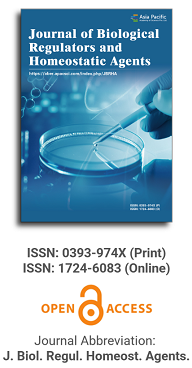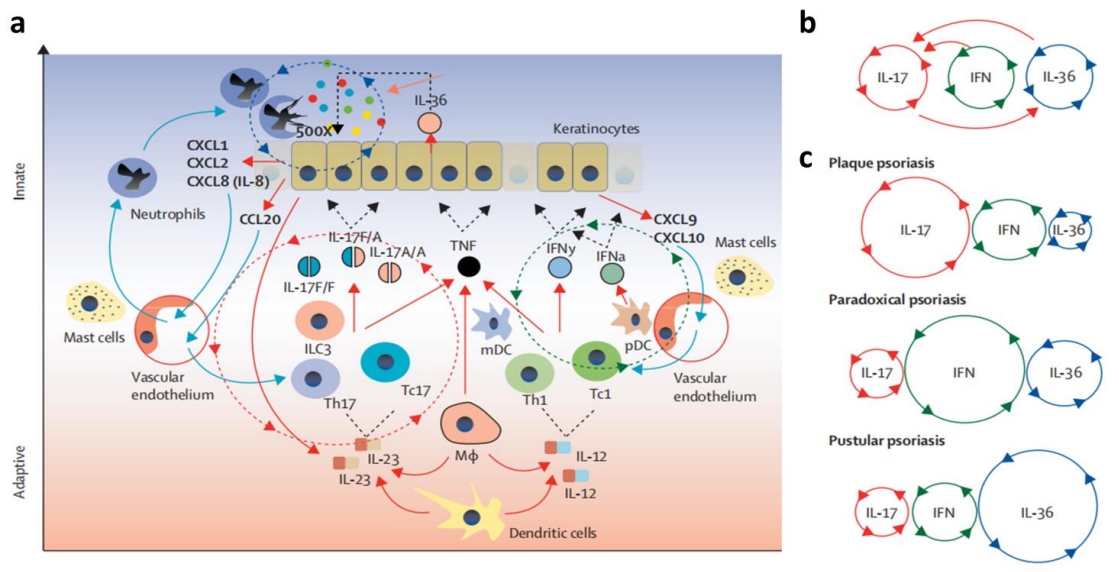
Publication Frequency
Quarterly since 2025
Journal Articles
Search
Search scope
Journal Center
Asia Pacific Academy of Science Pte. Ltd. (APACSCI) specializes in international journal publishing. APACSCI adopts the open access publishing model and provides an important communication bridge for academic groups whose interest fields include engineering, technology, medicine, computer, mathematics, agriculture and forestry, and environment.
Volume Arrangement
2025
Featured Articles

Psoriasis is a common, chronic, and inflammatory skin disease. Macrophages account for about 61.3% of the inflammatory cells infiltrating psoriatic lesions. Modulating macrophage polarization, inhibiting their infiltration, and targeting the secretion of inflammatory factors and associated inflammatory pathways by these cells can alleviate psoriasis symptoms and inflammation. Moreover, nanomaterials as novel drug carriers, offer unique advantages such as large surface area, easy modification, high biocompatibility, good biodegradability, enhanced systemic adsorption, etc. Nanomaterials have great potential for efficient drug delivery and release, as well as improving therapeutic efficacy while reducing adverse effects. By systematically addressing the role of macrophages in psoriasis pathogenesis and the potential of nanomaterials in treating psoriasis through modulating macrophages, this review enhances our understanding of the disease mechanism and holds promise for novel therapeutic breakthroughs and advancements in the future treatment of psoriasis.
Integration of clinical data with results from next-generation sequencing technology used to detect somatic and germline variants in patients with high-grade serous ovarian cancer
Article ID: 3392
Vol 39, Issue 2, 2025
DOI: https://doi.org/10.54517/jbrha3392
Vol 39, Issue 2, 2025
Received: 5 March 2025; Accepted: 13 March 2025; Available online: 14 April 2025; Issue release: 30 June 2025
Download PDF
Abstract
Ovarian cancer represents a significant global health issue, posing a significant challenge for the field of medicine. One strategy to improve the prognosis for women around the world is to implement modern technologies and apply the concept of personalized medicine. This study employed an in-depth case study of patients diagnosed with high-grade serous ovarian cancer. Advanced genetic testing methods and a comprehensive review of the patient’s medical history were utilized to identify new potential markers for early detection of the disease and eligibility for treatment. In this study, next-generation sequencing (NGS) technology was utilized for analysis. Tissue panel tests were performed to detect somatic mutations, while whole exome sequencing (WES) was conducted on blood samples to detect germline mutations. The results obtained were then analyzed in the context of the patient’s medical history to identify patients with a familial predisposition to cancer and to look for an association with comorbidities. The utilization of genetic testing and the analysis of patients’ medical histories facilitated the identification of somatic and germline variants in genes associated with carcinogenesis. This approach led to the identification of ovarian cancer-specific and novel variants. Furthermore, germline variants associated with comorbidities were identified. The utilization of contemporary molecular biology methodologies can markedly enhance the diagnostic accuracy of patients and allow the development of new diagnostic tests.
Keywords
ovarian cancer; HGSOC; NGS; WES; personalized medicine
References
- Sung H, Ferlay J, Siegel RL, et al. Global Cancer Statistics 2020: GLOBOCAN Estimates of Incidence and Mortality Worldwide for 36 Cancers in 185 Countries. CA: A Cancer Journal for Clinicians. 2021; 71(3): 209-249. doi: 10.3322/caac.21660
- Gaona-Luviano P, Medina-Gaona LA, Magaña-Pérez K. Epidemiology of ovarian cancer. Chinese Clinical Oncology. 2020; 9(4): 47-47. doi: 10.21037/cco-20-34
- Huang J, Chan WC, Ngai CH, et al. Worldwide Burden, Risk Factors, and Temporal Trends of Ovarian Cancer: A Global Study. Cancers. 2022; 14(9): 2230. doi: 10.3390/cancers14092230
- Ali AT, Al-ani O, Al-ani F. Epidemiology and risk factors for ovarian cancer. Menopausal Review. 2023; 22(2): 93-104. doi: 10.5114/pm.2023.128661
- Sambasivan S. Epithelial ovarian cancer: Review article. Cancer Treatment and Research Communications. 2022; 33: 100629. doi: 10.1016/j.ctarc.2022.100629
- Punzón-Jiménez P, Lago V, Domingo S, et al. Molecular Management of High-Grade Serous Ovarian Carcinoma. International Journal of Molecular Sciences. 2022; 23(22): 13777. doi: 10.3390/ijms232213777
- Chandrasekaran A, Elias KM. Synthetic Lethality in Ovarian Cancer. Molecular Cancer Therapeutics. 2021; 20(11): 2117-2128. doi: 10.1158/1535-7163.mct-21-0500
- Matthews B, Bowden N, Wong-Brown M. Epigenetic Mechanisms and Therapeutic Targets in Chemoresistant High-Grade Serous Ovarian Cancer. Cancers. 2021; 13(23): 5993. doi: 10.3390/cancers13235993
- Bukłaho PA, Kiśluk J, Nikliński J. Diagnostics and treatment of ovarian cancer in the era of precision medicine - opportunities and challenges. Frontiers in Oncology. 2023; 13. doi: 10.3389/fonc.2023.1227657
- Bound NT, Vandenberg CJ, Kartikasari AER, et al. Improving PARP inhibitor efficacy in high-grade serous ovarian carcinoma: A focus on the immune system. Frontiers in Genetics. 2022; 13. doi: 10.3389/fgene.2022.886170
- Hussen BM, Abdullah ST, Salihi A, et al. The emerging roles of NGS in clinical oncology and personalized medicine. Pathology-Research and Practice. 2022; 230: 153760. doi: 10.1016/j.prp.2022.153760
- Gorcenco S, Ilinca A, Almasoudi W, et al. New generation genetic testing entering the clinic. Parkinsonism & Related Disorders. 2020; 73: 72-84. doi: 10.1016/j.parkreldis.2020.02.015
- Hanssen F, Garcia MU, Folkersen L, et al. Scalable and efficient DNA sequencing analysis on different compute infrastructures aiding variant discovery. NAR Genomics and Bioinformatics. 2024; 6(2). doi: 10.1093/nargab/lqae031
- Garcia M, Juhos S, Larsson M, et al. Sarek: A portable workflow for whole-genome sequencing analysis of germline and somatic variants. F1000Research. 2020; 9: 63. doi: 10.12688/f1000research.16665.2
- Ewels PA, Peltzer A, Fillinger S, et al. The nf-core framework for community-curated bioinformatics pipelines. Nature Biotechnology. 2020; 38(3): 276-278. doi: 10.1038/s41587-020-0439-x
- Di Tommaso P, Chatzou M, Floden EW, et al. Nextflow enables reproducible computational workflows. Nature Biotechnology. 2017; 35(4): 316-319. doi: 10.1038/nbt.3820
- Vasimuddin Md, Misra S, Li H, et al. Efficient Architecture-Aware Acceleration of BWA-MEM for Multicore Systems. Proceedings of the 2019 IEEE International Parallel and Distributed Processing Symposium (IPDPS); 2019. doi: 10.1109/ipdps.2019.00041
- Cingolani P, Platts A, Wang LL, et al. A program for annotating and predicting the effects of single nucleotide polymorphisms, SnpEff. Fly. 2012; 6(2): 80-92. doi: 10.4161/fly.19695
- Bukłaho PA, Kiśluk J, Bauer W, et al. Results from studies using next-generation sequencing to detect somatic and germline variants in patients with high-grade serous ovarian cancer. Available online: https://doi.org/10.5281/zenodo.14710360 (accessed on 7 April 2025).
- Gronwald J, Cybulski C, Huzarski T, et al. Genetic testing for hereditary breast cancer in Poland: 1998–2022. Hereditary Cancer in Clinical Practice. 2023; 21(1). doi: 10.1186/s13053-023-00252-6
- Kowalik A, Siołek M, Kopczyński J, et al. BRCA1 founder mutations and beyond in the Polish population: A single-institution BRCA1/2 next-generation sequencing study. PLOS ONE. 2018; 13(7): e0201086. doi: 10.1371/journal.pone.0201086
- Kluska A, Balabas A, Paziewska A, et al. New recurrent BRCA1/2 mutations in Polish patients with familial breast/ovarian cancer detected by next generation sequencing. BMC Medical Genomics. 2015; 8(1). doi: 10.1186/s12920-015-0092-2
- Rogoża-Janiszewska E, Malińska K, Cybulski C, et al. Prevalence of Recurrent Mutations Predisposing to Breast Cancer in Early-Onset Breast Cancer Patients from Poland. Cancers. 2020; 12(8): 2321. doi: 10.3390/cancers12082321
- Shet D, Gatty RC. Impressive response to oral metronomic chemotherapy in ovarian cancer. Current Problems in Cancer: Case Reports. 2022; 8: 100197. doi: 10.1016/j.cpccr.2022.100197
Supporting Agencies
Copyright (c) 2025 Author(s)
License URL: https://creativecommons.org/licenses/by/4.0/

This site is licensed under a Creative Commons Attribution 4.0 International License (CC BY 4.0).
Editor-in-Chief

Medical Genetics, University of Torino Medical School, Italy
Co-Editor-in-Chief

Department of Biomedical, Surgical and Dental Sciences, University of Milan, Italy
Indexing & Archiving
News & Announcements
2025-02-01
In addition to the first issue that has already been published by the original publisher, there will be four more issues released this year, with scheduled publication dates in March, June, September, and December respectively.
2025-01-21
Starting from Volume 39 Issue 2 (2025), the ownership of Journal of Biological Regulators and Homeostatic Agents (ISSN: 0393-974X (P); 1724-6083 (O)) will be transferred from Biolife Sas to Asia Pacific Academy of Science Pte. Ltd. As of 21 January 2025, authors should make submissions to the new journal system and follow the author guidelines. Asia Pacific Academy of Science Pte. Ltd. will take over the publication of manuscripts being processed.

